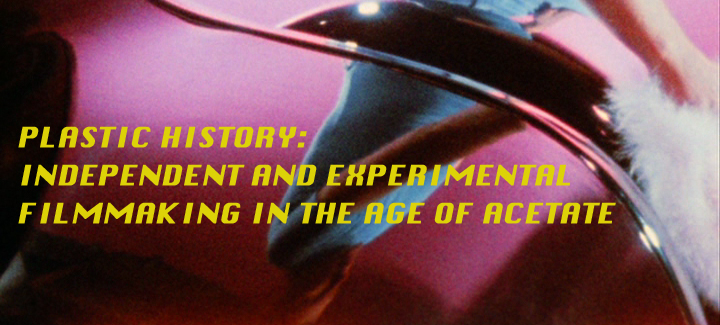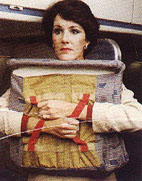PLASTIC HISTORY: Independent and Experimental Filmmaking in the Age of Acetate, A Program of Films Selected by Tyler Turkle — Canyon Cinema Salon, 11/24/2014
Please join Canyon Cinema on the evening of November 24th, 2014 at New Nothing Cinema for the next installment of our Fall 2014 Salon series. This month, artist and filmmaker Tyler Turkle will present a program of 16mm films from the Canyon Cinema catalog made in the 60s, 70s, and 80s. These films, along with being representative of the historical moment in which they were produced, are also important works in the development of Turkle’s art. Regarding this program, Turkle writes:
The films chosen represent a variety of ideas and take on numerous forms, from a home movie to a candid interview, to a personal portrait to the amusing street actions of a merry band of pranksters. However, all of these films stand as a partial historical record of the imaginative and adventurous use of the most “plastic” medium of them all.
Although there are many, many more examples to choose from, these are a few of the films that informed my own art and filmmaking in the late 1960s and early 1970s. I saw most of them as a student at Kent State University, taking classes with legendary filmmaker, Richard Myers. Later in the 70s and 80s, while teaching at Florida State University, I screened these and many others from the Canyon catalog to film classes and through a weekly experimental film and video program known as MEDIA X.
The Canyon Cinema Salon Series is a FREE event hosted at New Nothing Cinema (located at 16 Sherman St, off Folsom between 6th and 7th in SOMA).
7:00pm- Reception
7:30pm* – Screening and discussion.
*Note: Street entrance locked at 7:30 – please arrive on time.
Program Notes
Kustom Kar Kommandos (1965) | Kenneth Anger | 3.5 minutes | Color | Sound
“KUSTOM KAR KOMMANDOS was originally to be an eight-part, 30-minute film which Anger describes as ‘an oneiric vision of a contemporary American (and specifically Californian) teenage phenomenon, the world of hot-rod and customized cars.’ Anger made the episode presently shown as KUSTOM KAR KOMMANDOS to raise funds to finish the film, but was unable to do so and the project was abandoned.” – Marilyn Singer, The American Federation of Arts
Oh Dem Watermelons (1965) | Robert Nelson | 11 minutes | Color | Sound
“Original idea and inspiration from La Course aux Potirons (1907) by Louis Feuillade.” – RAN
“A major American underground classic. This film originally served as a theatrical intermission in the San Francisco Mime Troupe’s social-political satire “A Minstrel Show, or Civil Rights in a Cracker Barrel”, but it quickly took on a life of its own. Oh Dem Watermelons takes hilarious and absurd jabs at the watermelon as a tired Black stereotype, using a wild mix of collage, animation, and irreverence, set to a propulsive soundtrack by Steve Reich.” – Mark Toscano
Doggie Diner and Return of Doggie Diner (1969) | Leonard Lipton | 7 minutes | Color | Sound
“DOGGIE DINER and RETURN OF DOGGIE DINER satirizes and excels in formal, conceptual filmmaking and Peter Hutton’s July ’71 in San Francisco conveys sixties’ ideals through a series of beautiful, haunting tableaux.”—Steve Anker
The prospective renter needs no better recommendation than this: Peter Kubelka purchased a print for the Austrian Film Archive. Rent it while it’s hot.
My Name is Oona (1969) | Gunvor Nelson | 10 minutes | B&W | Sound
“But the revelation of the program is Gunvor Nelson, true poetess of the visual cinema. MY NAME IS OONA captures in haunting, intensely lyrical images fragments of the coming to consciousness of a child girl. A series of extremely brief flashes of her moving through night-lit space or woods in sensuous negative, separated by rapid fades into blackness, burst upon us like a fairy-tale princess, with a late sun only partially outlining her and the animal in silvery filigree against the encroaching darkness; one of the most perfect recent examples of poetic cinema. Throughout the entire film, the girl, compulsively and as if in awe, repeats her name, until it becomes a magic incantation of self-realization.” – Amos Vogel, The Village Voice
“It is one of the first filmic masterpieces of the new wave films.” – Larry Jordan
Visit to Indiana (1970) | Curt McDowell | 10 minutes | Color | Sound
“… it is not only very funny, but perfectly designed to satirize the Midwestern life style. The film may be no more than a sound track, but even if you listen with your eyes closed, you should enjoy it.” – LA Free Press
“A powerful, controversial film for discussion in senior high school language arts and social studies classes and college courses in sociology and psychology. Also for public library film programs and loan to groups interested in films heavy with social comment. Ages 16 to adult.” – The Booklist, American Library Association
Akbar (1970) | Richard Myers | 16 minutes | Color | Sound
A conversation with a friend – Ahmed Akbar. A short interview-type film portrait with Akbar, a black filmmaker and former student of [Myers’] at Kent State. AKBAR expresses an unusual and exciting view of himself/blacks in America/and such varied subjects as “This moon race Shit!” A friendly, lively, exciting portrait of a very extraordinary person from Akron, Ohio.
Songs for Swinging Larvae (1981) | Ralph Records, aka Cryptic Corporation | 6 minutes | Color | Sound
A child’s perverse fantasy about escaping from his mother becomes reality and then a nightmare in this brilliantly acted and staged film from the creator of HELLO SKINNY and The Residents’ ONE MINUTE MOVIES. Entertaining and scary. Music is by the band Renaldo and the Loaf.
About the Artist:
Tyler Turkle is an artist engaged in making paintings, sculptures, films and videos. He studied art and photography while obtaining a degree in History from Mount Union College (1970) and furthered his studies in cinematography at Kent State University (1973-74) where he worked with the acclaimed American filmmaker Richard Myers.
While at Kent State, Turkle was exposed to the avant garde/experimental films and filmmakers of the day – Myers, Bruce Conner, Stan Brakhage, Mike and George Kuchar, Jonas Mekas, Gunvor Nelson, Lenny Lipton, Ed Emshwiller, among others. Many of those filmmakers were also producing artwork in other media and Turkle began to make films within the framework of his other art projects. The idea was that films are products of the critical, artistic process just like paintings and sculpture in that they are all projects of an independent and highly personal enterprise. Turkle’s main interest, then and now, is the short documentary film and video, mostly constructed around on-camera interviews. His interest in the moving image corresponds to his interest in the still image as both play back and forth across the fields of painting and sculpture. Over the last forty years, his films and videos have explored subjects as far ranging as kids playing with yo-yo’s to the death of a friend, all of which are based on the working premise of one idea, one artist, working mainly alone and out of the mainstream.
Turkle’s films and videos have been shown with his paintings and sculptures in museums and galleries throughout the United States and Europe including the San Francisco Museum of Art, Herbert F. Johnson Museum – Cornell University, Modern Art Museum of Fort Worth, and the New Orleans Museum of Art. Many of the films and videos have also been shown in film festivals including the New York Independent Filmmakers Exposition, Bellevue(WA) Film Festival, Athens International Film Festival, Oxford Film Festival, Penn State Film Festival, Rooseum, Malmo, Sweden and the Sherwood Oaks (CA) Experimental Film Festival.



